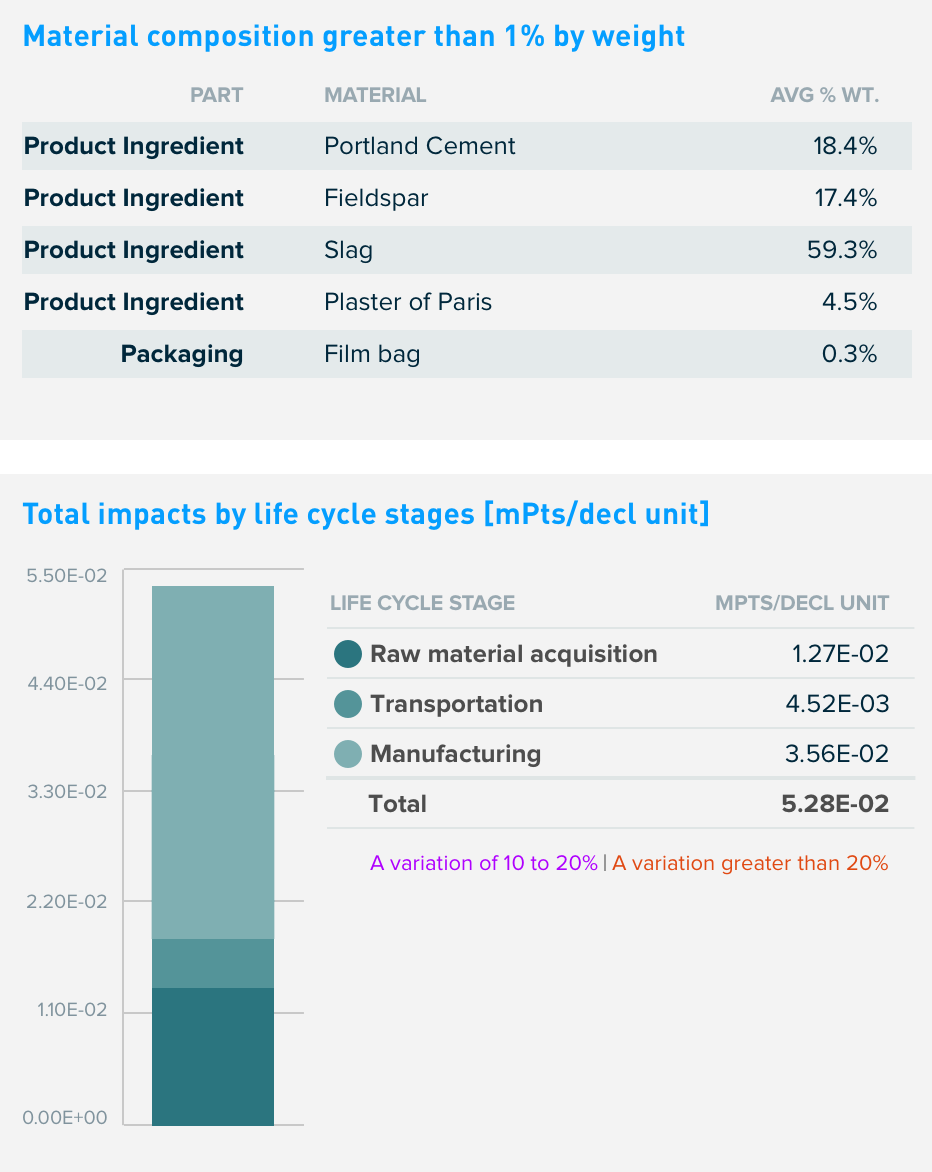LCA & material health results & interpretation CAFCO® BLAZE-SHIELD® II, II HS & HP
Scope and summary
- Cradle to gate
- Cradle to gate with options
- Cradle to grave
Application
CAFCO® BLAZE-SHIELD® products contain a unique inorganic, environmentally friendly, Portland cement- based formulation that provides superior fire resistance for structural steel and concrete in commercial construction environments.
These are the products of choice particularly when exposure to severe weather conditions during the construction phase is necessary, or when application efficiency, along with excellent thermal and acoustical insulation properties are desired.
CAFCO® BLAZE-SHIELD® II HS is a high strength commercial density, Portland cement based Spray-Applied Fire Resistive Material (SFRM) that is specially formulated to satisfy the International Building Code (IBC) bond strength requirement for buildings up to 420 ft in height.
Declared unit
1,000 kg of spray-applied fire resistive material, packaging included.
Manufacturing data
Reporting period: January 2017 – December 2017
Location: Huntington, IN
The amount of water required to be added during the mixing and application of 1,000 kg of dry product is 334 gallons. This water consumption will cause additional environmental impacts in the use phase, which is out of the scope of this assessment.

What’s causing the greatest impacts
All life cycle stages
Overall, the raw material aquisition stage dominates the results for impact categories. Followed closely behind by the manufacturing stage. The overall lowest impacts come from the transportation stage.
Raw materials acquisition stage
The impact of the raw material acquisition stage is mostly due to the Portland cement and levy slag. This is because of the high material weights used in manufacturing.
Sensitivity analysis
There are no notable variations.
Multi-product weighted average
Results represent the weighted average using production volumes for the products covered. Variations of specific products for differences of 10–20% against the average are indicated in purple; differences greater than 20% are indicated in red. A difference greater than 10% is considered significant.
Isolatek minimizes our waste portfolio by employing a variety of efforts, including the reuse of recycling of spent materials where feasible.
Isolatek offers the most thermally efficient materials on the market, meaning less material is needed to complete a project.
LCA results
| Life cycle stage | Raw material acquisition | Transportation | Manufacturing | Total |
|
Information modules: Included | Excluded |
A1 Raw Materials | A2 Transportation | A3 Manufacturing | A1-A3 Total |
 |
 |
SM Single Score
Learn about SM Single Score results| Impacts per declared unit | 1.27E-02 mPts | 4.52E-03 mPts | 3.56E-02 mPts | 5.28E-02 mPts |
| Materials or processes contributing >20% to total impacts in each life cycle stage | CAFCO® BLAZE-SHIELD Series raw material production. | Truck and rail transportation used to transport raw materials to manufacturing site. | Energy and ancillary materials required to make the passive fire protection product. | Sum of the single point scores. |
TRACI v2.1 results per declared unit
- A variation of 10 to 20%
- |
- A variation greater than 20%
| Life cycle stage | Raw material acquisition | Transportation | Manufacturing | Total |
Ecological damage
Human health damage
Additional environmental information
| Impact category | Unit | ||||
| Ecotoxicity | CTUe Comparative Toxic Units of Ecotoxicity Ecotoxicity causes negative impacts to ecological receptors and, indirectly, to human receptors through the impacts to the ecosystem. |
6.84E+01 | 1.93E+02 | 3.07E+01 | 2.92E+02 |
| Fossil fuel depletion | MJ, LHV Mega Joule, lower heating value Fossil fuel depletion is the surplus energy to extract minerals and fossil fuels. |
1.81E+02 | 9.72E+01 | 1.24E+02 | 4.02E+02 |
References
LCA Background Report
Isolatek Products LCA (public version), Isolatek 2019. SimaPro Analyst 8.5.2.0, EcoInvent 3.1, 2.2 database.
PCR
ASTM PCR for Spray-Applied Fire Resistive Materials; Version 1.0, February 2022. PCR review conducted by Thomas Gloria, PhD (chair, [email protected]); Jeffrey Gould; and Karl Houser.
ISO 14025, “Sustainability in buildings and civil engineering works -- Core rules for environmental product declarations of construction products and services".
Independent external verification of the declaration and data, according to ISO 14025.
 Download PDF SM Transparency Report/Material Health Overview, which includes the additional EPD content required by the ASTM Environment PCR.
Download PDF SM Transparency Report/Material Health Overview, which includes the additional EPD content required by the ASTM Environment PCR.
"Transparency Reports™ / environmental product declarations enable purchasers and users to compare the potential environmental performance of products on a life cycle basis. They are designed to present information transparently to make the limitations of comparability more understandable. TRs/EPDs of products that conform to the same PCR and include the same life cycle stages, but are made by different manufacturers, may not sufficiently align to support direct comparisons. They therefore, cannot be used as comparative assertions unless the conditions defined in ISO 14025 Section 6.7.2. ‘Requirements for Comparability’ are satisfied." EPDs from different programs (using different PCR) may not be comparable. TRs/EPDs cannot be compared if they do not have the same functional unit, reference service life, and building service life.
 SM Transparency Report (EPD)
SM Transparency Report (EPD)